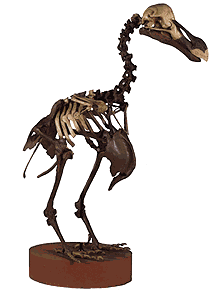tags: Dodo, Raphus cucullatus, birds, ornithology, Mauritius
Dodo reconstruction reflecting new research at Oxford University Museum of Natural History.
The most complete skeleton of an extinct Dodo, Raphus cucullatus, ever found was discovered recently in the highlands of Mauritius, an island located in the Indian Ocean. Because this skeleton was preserved intact and isolated in a cave, it appears that it might provide an excellent DNA source for numerous scientific studies, according to the scientist who recovered it. Dodo remains are rare and precious finds: the last time Dodo skeletons were discovered was in 2005, when a mass grave was found in the southeastern part of the island known as Mare aux Songes. Prior to that, Dodo remains were found in 1920.
"The geneticists who want to get their hands on this will be skipping down the street," gloated Julian Hume, a palaeontologist at London's Natural History Museum, after recovering the last of the remains.
The skeleton was given the nickname "Fred" in honor of the 65-year-old man who found it. DNA isolated from small samples of bone will be used in molecular studies that might reveal geographic and genetic relationships between the Dodo and other closely-related birds species.
Dodos are flightless birds that are thought to be related to pigeons. They weighed between 28.6 to 50.6 pounds (13 to 23 kilograms) each and were covered with soft, grey feathers and had a white tail plume (see top image). They became extinct in the 17th century, only 80 years after they were first discovered.
"Then you can work out how it actually got to Mauritius, because it must have originally flown here before evolving into flightlessness and the big, fat bird that we know," Hume explained.
The Dodo, whose name sounds similar to the Portuguese word for "fool", was first discovered by Portuguese sailors in the late 16th century. Even though it was rumored that the bird, which was fearless, was driven to extinction by Dutch seafarers, the Dodo was more likely a victim of the animals that were brought to the islands by sailors, such as rats, dogs, pigs and goats.

The cave where the Dodo skeleton was discovered was located beneath several bamboo and tea plantations but the site was kept secret until last Friday. So precious is this skeleton that the cave was guarded by four men every night until it was completely recovered.
This was the first time that dodo remains were found away from coastal regions, suggesting that the bird lived all over the Indian Ocean island.
The skeleton, a pre-fossil, was very fragile. (see image of another skeleton, left. Courtesy of AMNH).
"If you try and pick it up, it just falls apart," Hume said. "You won't see a mounted, beautiful thing from this."
Of course, because of the fragility of the skeleton, this means that one should remain circumspect as to whether usable DNA can be extracted from the bones. Instead of intact DNA, it seems this particular find is most likely to provide unambiguous evidence as to the proper articulation of an ancient extinct bird species.
Cited story.


Congratulations! You've been named for a Rockin' Girl Blogger award in recognition of your rockin' ways. Come pick up your badge and name five new Rockin' Girl Bloggers!
Head's up :
Surge of Dead Seabirds Alarms Scientists
http://www.newsvine.com/_news/2007/07/03/817058-surge-of-dead-seabirds-…
That's a very well thought out and informative article. I do hope you're wrong about intact DNA though, as it would be my dearest held wish that we would see them roam the earth again.